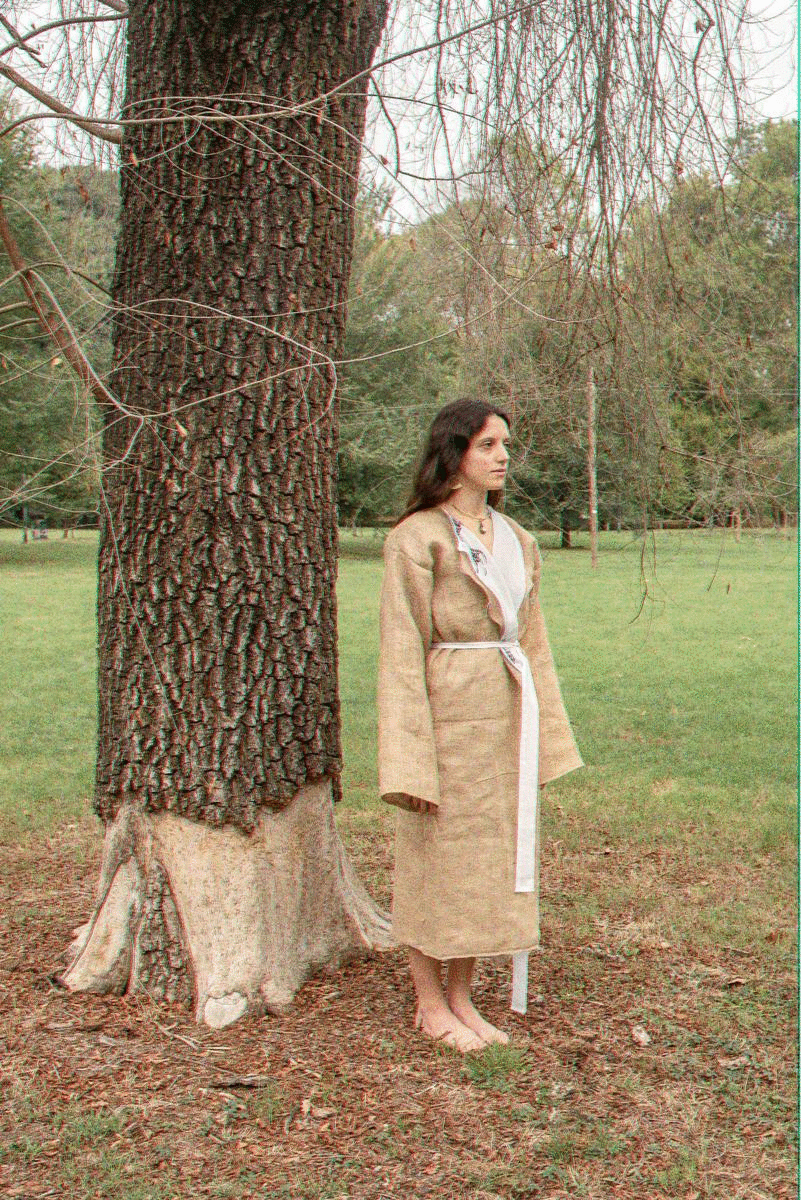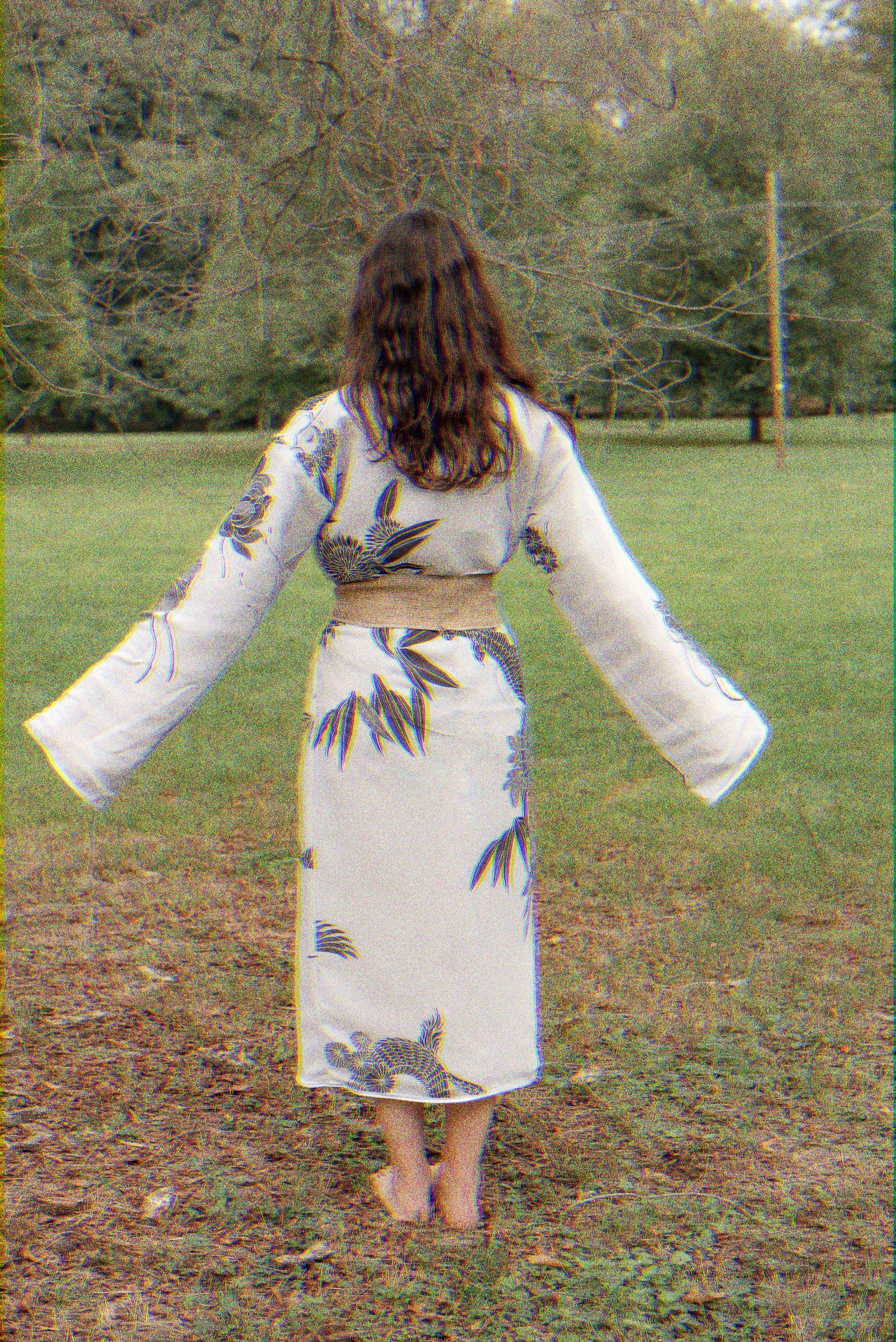
Incontri Generazionali
a project by Chiara Andolina and Tonia Paladini
curated by Vittoria Mascellaro
juta, seta, cotone, colori per tessuto, 160x120 cm, 2021
The thousand-year history of the olive trees is now forced to deal with annoying Xylella, a bacterium that consumes the entire productive olive and olive oil of Salento. Symbolic of the tradition of the Apulia area, the wide expanses of lush olive trees give way to an arid and desert landscape, undermining the planning of the territory and symbolizing a metaphorical abandonment of tradition.
A result very close to what happens with cultural appropriation in the field of fashion, through the reinterpretation of specific clothing, deprived by this sense of their usual cultural role.
Incontri Generazionali arises from the union of these two aspects: the need to create a dress, in particular a kimono, in which cultures serve as a support to the memory of tradition itself.
![]()
The thousand-year history of the olive trees is now forced to deal with annoying Xylella, a bacterium that consumes the entire productive olive and olive oil of Salento. Symbolic of the tradition of the Apulia area, the wide expanses of lush olive trees give way to an arid and desert landscape, undermining the planning of the territory and symbolizing a metaphorical abandonment of tradition.
A result very close to what happens with cultural appropriation in the field of fashion, through the reinterpretation of specific clothing, deprived by this sense of their usual cultural role.
Incontri Generazionali arises from the union of these two aspects: the need to create a dress, in particular a kimono, in which cultures serve as a support to the memory of tradition itself.

Incontri Generazionali: the ritual of tradition livens up the kimono of Chiara Andolina and Tonia Paladini
The poetics of the ritual echoes in the fabric of the combined garment.
The filament makes spaces in the jute in order to draw an olive branch. Here what is used as a container of fruit from Salento becomes a new canvas of expression. The need to give another life to the bare trees makes the possibility to write a new encounter.
A traditional confrontation escapes from historical and cultural dimensions, which leaves the cotton filament to animate the dress and offers the idea of generation. At the same time, the movement of the silk drawings tells a different story, distant at a spatial level, but still attacked by everyday life. The gaze moves from the West to the East. From the defeat of the territory to the cultural reappropriation, Incontri Generazionali is the symptom of a double hope that is embodied in the fabric.
The purity and prized value of silk, contrasted by rough jute, maintains the naivety of a narrative that can be written again and transcribed. The heterogeneity of Chiara Andolina and Tonia Paladini as artists, as well as the very essence of their practices, generates a singular union, so complete, that sometimes it is almost uncomfortable.
Worn by multiple bodies or by a single one, the kimono allows an intriguing reflection on the role that we have in our society. The main focus is to think about human actions and how they affect the system and nature too. That is the reason why this highly desired contamination is necessary in order to think about today and tomorrow in an active way. The attention on memory and tradition is here constant and it acts as a narrative substrate to understand the choices of the two artists.
Incontri Generazionali is a real terrestrial conjunction that changes the observation of the world. In this way it is evident that a shared narrative unites the lives of human beings.
Text by Vittoria Mascellaro
Chiara Andolina (Sesto San Giovanni (MI), 1996). After she received her academic diploma in Visual Design and Illustration, she started working as textile designer in Lomazzo (Como, IT).
Her work is based on the creation of designs by traditional technique and digital one.
She has always been interested in the relationship between the self and the other, the judgement and the awareness. Accordingly to this, she investigates the sphere of vulnerability through drawing, painting, collage and installation.
Tonia Paladini (Lecce, 1997). She is a photographer and video maker.
After she received her degree in New Technologies in Brera and a master degree in Other Photography at Politecnico in Milan, she started studying Visual Arts and Curatorial Studies in NABA.
In December 2020 she founded a new eco-friendly brand: Yumi handmade. It is a family-run project currently engaged in the realisation of hand-made garments done by yarns made from raw materials. Actually her artistic research is about territory and industrial agriculture.
Vittoria Mascellaro (Monza, 1996). After she received a degree in Philosophy at Università Statale in Milano, she started attending a two-year specialisation in Visual Arts and Curatorial Studies in NABA.
Her research is focused on the distance between the “I” and the “other” and the instrict relationship that follows from it. In 2021 she started writing for Artribune and Holotipus Magazine.
She is currently living in Lisbon, where she is working on a research about social and engaged art, at Faculdade De Belas Artes ULISBOA.


